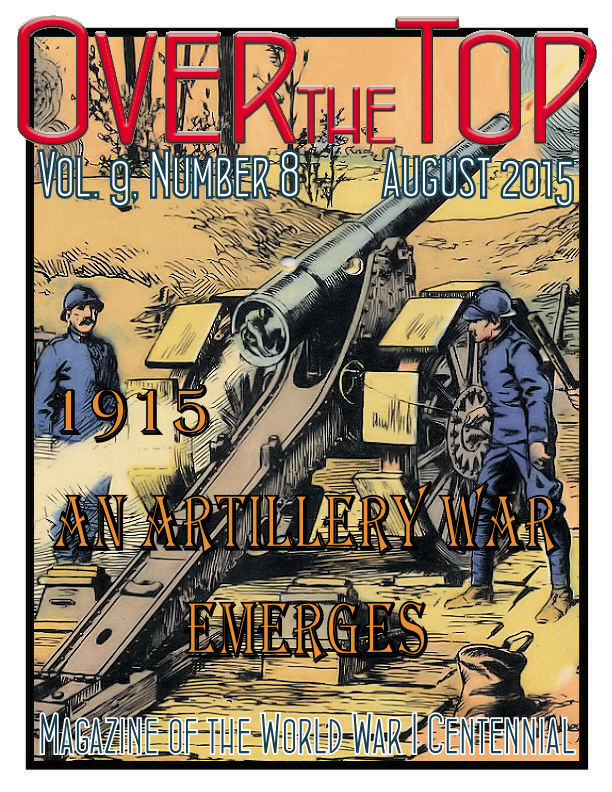
August & September 2015 |
 |
|
|


Western Front Trip Report 4
On my 2015 spring tour — after a quarter century visiting the Western Front — I finally got to stop in at Toc H in Pop. This year is the centennial of its founding after all.
Talbot House in Poperinge was the rank-free respite site for the British soldiers located near the rail hub just west of Ypres. Not only could the men socialize over a cup of hot tea, or find a moment of rare solitude, but founder Tubby Clayton also organized stage shows and concerts. Men could post messages for their missing comrades. The fellowship survived the war, giving birth to a worldwide movement to foster friendship, operate hostels, and encourage service.
The original Toc H in Poperinge is today operated by rotating volunteers from around the world. It has been wonderfully preserved. All the facilities the troops enjoyed can be visited and there is a small but well-done museum that helps to the story of what was an oasis of sanity in the war. Do visit, if you ever find yourself in the Ypres Salient neighborhood.
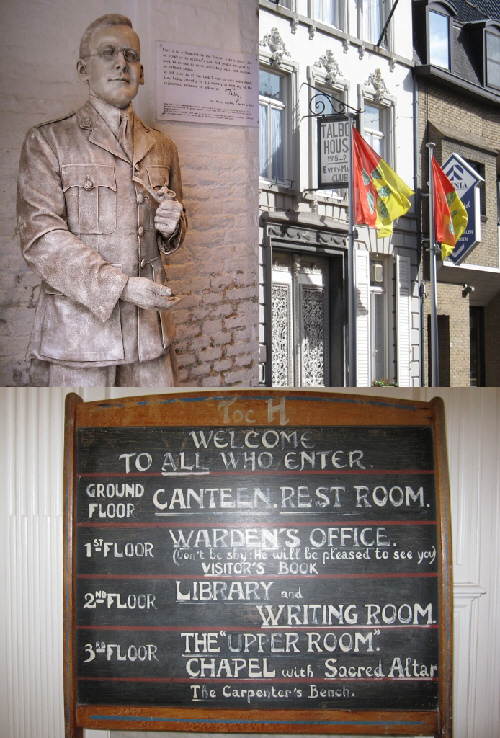
From the top: Founder Tubby Clayton, the Original Entrance; Welcome Sign
Speaking of my Centennial battlefield tours, I'll be off to the Western Front soon so this issue will have to cover both August and September. We will continue to have new postings daily, on our Blog, Roads to the Great War, however. If you haven't done so, please check in and subscribe at: Roads. . . MH

|
|
2015
1915: Warfare Evolution; New Strategies and Tactics: A National Symposium on World War I
When: 2 & 3 October 2015, All Day
Where: Lisle/Napierville Hilton (Outside Chicago; Includes visit to nearby First Division Museum at Cantigny)
Sponsors: World War One Historical Association and the League of WWI Aviation Historians; click HERE for full program and registration.
Over the Front, Mid-Atlantic Chapter Meeting
When:17 October 2015, All Day
Where: National Air and Space Museum’s Steven F. Udvar-Hazy Center
Sponsors: The League of WWI Aviation Historians; click (email BobrowC@si.edu) for full program and details.
|
Local and Ongoing Events
The interest in the Great War generated by the Centennial commemorations has led to an explosion of local events and ongoing displays of art and artifacts from the war. We simply lack the space here to include them all. Fortunately, however, the staff of the Centennial Commission has taken on the job of providing a list of all these presentations they hear about. Click HERE to view the current list.
|
Remembering Mobilization
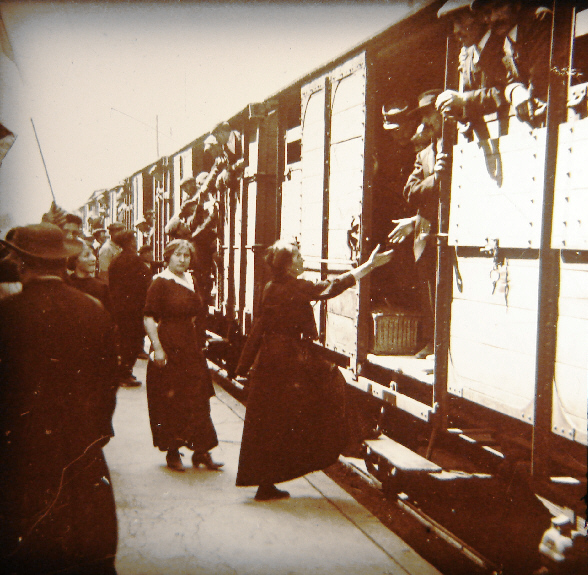
Following Our Centennial Calendar, It's One Year Since the August 1914 Mobilization. Very likely, a Number of the Men in This Photo Had Already Perished. (From Olivier Pierrard)

The U.S. Marines in the Great War
The U.S. Marines got to France early, elbowed their way onto the order of battle, and ended up fighting in all the major actions of the AEF. It wasn't just Belleau Wood, and the Marine Corps contribution to victory went beyond the events on the front line.
 USMC in WWI (Official History, Pdf)
USMC in WWI (Official History, Pdf)
 USMC in WWI (Chronology)
USMC in WWI (Chronology)
 Organizing the 4th Marine Brigade
Organizing the 4th Marine Brigade
 Those "Other" U.S. Marines (Not in the 4th Brigade)
Those "Other" U.S. Marines (Not in the 4th Brigade)
 Authentic Recreation of Initial Attack on Belleau Wood (Video)
Authentic Recreation of Initial Attack on Belleau Wood (Video)
 Virtual WWI Experience from the USMC National Museum
Virtual WWI Experience from the USMC National Museum
 A Forgotten Marine Battle: Soissons
A Forgotten Marine Battle: Soissons
 A Forgotten Marine Battle: Blanc Mont
A Forgotten Marine Battle: Blanc Mont

Ballet and the War

A Recent Staging
There is a ballet that will forever be associated with the Great War. It was not set on a battlefield, but it was certainly a premonition of the unbridled violence soon to come. Contributor Diane Rooney explains:
On 29 May 1913 the ballet The Rite of Spring (Le Sacre du Printemps), premiered in Paris. It caused a riot. Igor Stravinsky's ballet is set in pagan Russian times; the rite of spring is the ritual sacrifice of a maiden (The Chosen One) to ensure successful crops. The music, choreography, costumes, and staging were unlike anything ever seen before: discordant, irregular, and wild. At least 40 attendees were taken away by the police.
The premiere soon came to be seen as a cultural fracture point — evidenced by the breaking of the fourth wall, the lack of familiar music and dance structure, the public release of wild, even violent emotion, the display of ritual violence on stage, and the breakdown of established norms of behavior. Symbolically, it came to represent or foreshadow the unrestrained horrors of the Great War and the sweeping social and cultural changes that followed it. Diane Rooney

7 August 1915 at Suvla
Eight hours after the battle first began to
spread from the south, the British force
made a fresh landing at Suvla Bay , about
four miles north of Anzac. About 3 o’clock
on Saturday morning the sound of their
rifles could be heard from the north of our
lines. All that day troops could be seen
landing, with Turkish shrapnel bursting
over the beach and the low hills near it. By
the next morning, however, we noticed that
the Turkish shell was bursting over a hill,
on a plain to the northward from which a
battery of Turkish guns had for nearly four
months played on Anzac.
Capt. C.E.W. Bean, Correspondent
|

|

U.S. Centennial Organizations & Resources
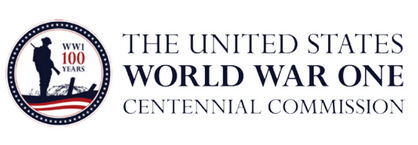
worldwar-1centennial.org/

theworldwar.org/
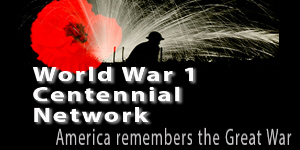
www.ww1-centennial.org/

www.firstdivisionmuseum.org/

www.abmc.gov/
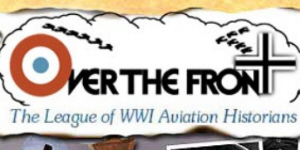
www.overthefront.com/

www.nationalmuseum.af.mil/

www.worldwar1.com/dbc/

facebook.com/wwiinventory

wisconsinhistory.org/

www.uswarmemorials.org/

www.macarthurmemorial.org/

www.saving-hallowed-ground.org/
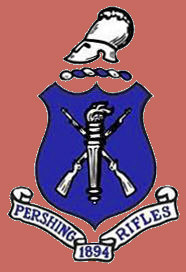
www.theprgroup.org/
Support Worldwar1.com's Centennial Effort
Shop at Amazon.com
|
The Centennial Ticker
Just Fabulous!
An Overwhelming Response for the
WWI Memorial Design Completion
The World War I Centennial Commission has received an astonishing 359 entries for the first phase of the design completion that just ended. According to World Landscape Architecture, "The overall design quality of the submissions designs is high with many submissions providing great representation of the overall design intent [with] many outstanding examples of architecture and landscape architecture design."
Here is sampling of the entries. All are displayed on the standard display boards for each entrant. Design entries for the first phase had to presented on one, single 30" x 40" PDF.

A Selection of the Display Panels
Every display board (in large, readable format) can be viewed
(here). Phase II of the competition is already underway. Each entry is being analyzed by the design committee and out of their review will come a list of five finalists. This selection is scheduled to be made by mid-August. The committee, though, wants your advice. They have made it remarkably easy to offer suggestions, likes or dislikes, on every entry. Just go to the display page and you will see what I mean.
A personal comment — So far, I have only had time to examine about 20 of the panels, but it has been enjoyable to get a ringside seat to a creative competition among the nation's most talented designers. The variety of imaginative solutions based upon the same theme, to be built on the very same parcel of land, has been eye-opening. The treatments I've seen range from strongly structural to almost pure landscaping, from classical style to futuristic, and from focusing on a single individual's experience to the war's effect on the community of nations. Take a look, you'll feel proud.
Operation Door Knock
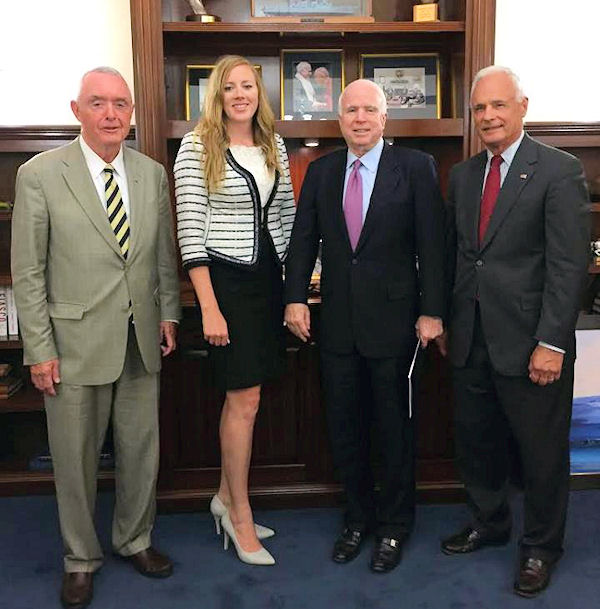
General Barry McCaffrey, Rebekah Wilson of the Commission Staff, Senator John McCain, and WW1CC Commissioner Tom Moe
In July, the U.S. World War One Centennial Commission (WW1CC) reached out to Congress, to increase the visibility of the Commission, and to foster support for our WW1 education and public awareness programs. The delegation was led by the Chair of the Commission, Colonel Robert J. Dalessandro, USA (Ret.) and Commissioner Tom Moe, and includes the Commission's senior advisor for development, General Barry McCaffrey, USA (Ret.).
The Commission's teams met with a host of senior leaders – including House Speaker John Boehner, Senate Democratic Leader Harry Reid, House Appropriations Chairman Hal Rogers, and Senator John McCain. Overall, the WW1CC were hosted by 34 Congressional offices. These meetings gave the Commission the opportunity to tell the WW1 story to political leaders at the national level.
The visit to the Hill kicked off on Tuesday, July 21, with an outdoor media event at the Capitol, featuring guest speakers General McCaffrey and Texas Congress member, Rep. Ted Poe, escorted by Commission volunteers in Doughboy uniforms. That event was followed by three days of office-call meetings with various Congress members, Senators, and their staffs. At these meetings, the current status of the WW1CC, its future goals, and ideas on how to achieve them were discussed.
The Devil Dogs Got Funded!
Last month we strongly recommended that you consider contributing to a Kickstarter project to finance a documentary film about how French battlefield historian and honorary U.S. Marine Gilles Lagin supports the remembrance of America's sacrifices in the war. I'm pleased to announce that project has been fully funded. Thanks to those of you who contributed. We will have more on the film as its release draws near.
You can learn more about Devil Dogs by visiting the documentary's Kickstarter page at:
https://www.kickstarter.com/projects/devildogs/the-devil-dogs?lang=en
|
|

August 1915:
The Pershing Family Tragedy
at the San Francisco Presidio
At about 4 am on 27 August 1915, while Brigadier General John J. Pershing was deployed in Texas with his command, the 8th Infantry Brigade, the upper story of his quarters at the San Francisco Presidio suffered a severe fire set off by a coal-fired stove. In the fire, Mrs. Frances Pershing and three daughters, Mary, 6, Anne, 7, and Helen, 8 years old, all perished. Pershing's son, Warren was on a lower floor and escaped with the help of a soldier returning to barracks. This was the great tragedy of Pershing's life.
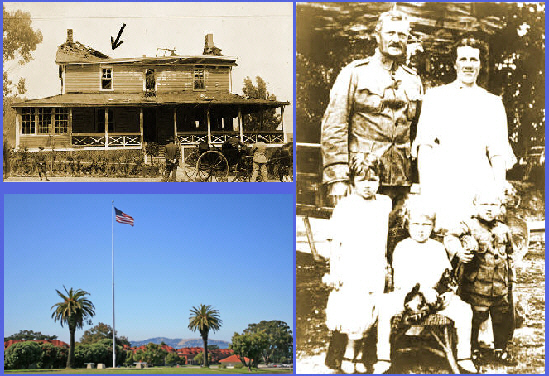
The Fire Scene, 1915; Pershing Square Today
General and Frances Pershing with Three of the Children in the Philippines
All of the other seven persons sleeping at the residence that night escaped from the fire. Later it was established that the four had been killed by suffocation. Nearly all the rest suffered from shock and minor injuries. An investigation disclosed that the fire was caused by live coals dropping from an open grate upon
the floor. It fell upon Pershing friend Major James Harbord, who was on the post commanding a ceremonial cavalry detachment supporting the nearby World's Fair, to notify Pershing of the
terrible event. Thinking perhaps to save the general some
shock, Harbord addressed the telegram to Pershing's aide. The
aide, however, was absent, and the El Paso operator read the
telegram to Pershing himself. The general had been expecting
his family to visit El Paso only a few days away.
Pershing rushed to San Francisco, arriving Sunday August
29. Mrs. Pershing's parents, U.S. Senator and Mrs. Francis
E. Warren arrived that same day. Pershing first visited the
funeral home then went to the burned-out residence and
finally to see his son who had been taken to Letterman General
Hospital. Twenty-four Presidio sergeants accompanied the
cortege to the train that afternoon and the mourners departed
for Cheyenne, Wyoming.From: Defender of the Gate: The Presidio of
San Francisco, 1846 to 1995
|
There will be a Centennial Pershing Family Remembrance held at 2 pm at Pershing Square and the former Officers Club at the San Francisco Presidio on 27 August 2015. The event will include a wreath laying ceremony at the site where Mrs. Frances Pershing and three of the Pershing daughters perished on 27 August 1915, followed by an information presentation on General Pershing's career, the family tragedy, and the Presidio during the Great War. All are invited. There is no charge for the event, but adjacent parking is metered.
|
|
|

Announcing Our 2016 Centennial Tour Schedule

On behalf of Valor Tours, Ltd. I am happy to announce that I will be leading two tours for the company next year —
2 - 10 May 2016: Verdun In-Depth
14 - 21 August 2016: The Somme In-Depth
The full brochure covering both trips and registration details can now be downloaded at:
(http://www.worldwar1.com/pdf/ValorTours_2016Flyer.pdf)
|
|
|

|

This Month's Recommended Great War Author —
Jacqueline Winspear
The Changing World of Maisie Dobbs in the Aftermath of World War I
Contributed by Jane Mattisson Ekstam
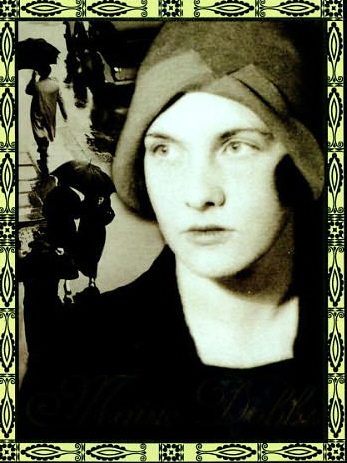
Maisie Dobbs
(Original Cover Art, MD #1) |
Maisie Dobbs, a private investigator, is the creation of English-born Jacqueline Winspear, who immigrated to the USA in 1990. The eleven Maisie Dobbs novels are set in the aftermath of World War One and have been written over a period of twelve years, starting with Maisie Dobbs (2003), and concluding with A Dangerous Place (2015). Winspear has also written a standalone novel on the war, The Care and Management of Lies (2014), which focuses on the home front during the first couple of years of the war. The Dobbs novels cover the time span 1929 to 1937 and, with the exception of the most recent novel, which is set in Gibraltar, they are set in England. Winspear's investigator learns to come to terms with her experiences as a Voluntary Aid Detachment nurse on the western front and puts these to good use in tracking down criminals. The crimes investigated often have a direct connection with the war. How has the war shaped Dobbs as a woman and as an investigator, and how does she develop during the eleven novels? The woman and the investigator in the most recent novel have learned to cope with loss, have slain the dragon of memory, are stronger and more rounded and ready to take up the old life but with new and important insights.
Winspear's novels are based on the idea that "stories . . . are never just stories. They contain fundamental truths about the human condition" (Birds 264). They are composed of "layers of truth" and "webs of lies" (Revenge 219). As such, the novels are powerful illustrations of what a war can do to the individual and to society at large. They are also excellent sources of knowledge about how the English nation struggled to come to terms with the effects of World War One socially, economically and psychologically. Dobbs is on a pilgrimage in which, as her mentor Maurice Blanche explains, "we are forced to shed the layers upon layers we have carried for so long. Then we find that our load is lighter and we have come to know something of ourselves in the perilous climb" (Pardonable Lies 66). This important lesson is accentuated in the ninth novel, where Blanche tells Dobbs that "in delving into the secrets held by the dead, by the living, and by those who have come to harm and caused harm, you will learn much about yourself. You will be challenged by this knowledge, and will be drawn to self-examination and - perhaps - recrimination" (Elegy 138-9). Towards the end of the most recent novel, Dobbs acknowledges that "I will prevail. I am resilient" (Dangerous Place 272). This is not only evidence of Dobbs' development but, hopefully, a promise to the reader that there are more Maisie Dobbs novels to come.
Dobbs the woman is overshadowed by Dobbs the detective. In the first two novels, Maisie Dobbs and Birds of a Feather, she is troubled by memories of the war and of her lover, Simon Lynch, an army doctor who was wounded while conducting an operation and whose personality was changed forever. The war is depicted as a monster which tightens its grip on Dobbs so that by the ninth novel in the series the narrator comments that "war was more than a place; it was a monster, a thing at once alive and dead and predatory, and it could be the root of a newfound hell anywhere. Like a new island born of a volcanic eruption, it could even create havoc before fully formed. Yes, war was a country, and (Dobbs) had been there" (Elegy 252). The young investigator carries the monster with her everywhere. It is clear that it is her work that enables her to come to terms with her experiences at the front. This is implied throughout the series but clearly stated in the tenth novel, Leaving Everything Most Loved, where it is compared to "a steadfast rock that had grounded her through the journey of recovery from the wounds of war, especially those lingering in her soul" (88).
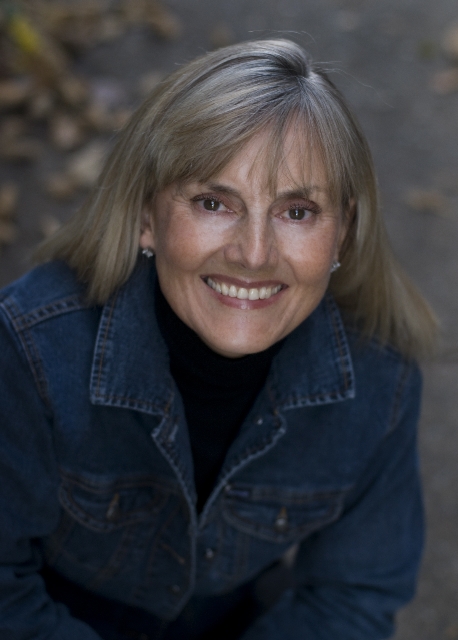
Author Jacqueline Winspear |
Despite her struggles, or perhaps because of them, Dobbs is known for her compassion. This is seen over and over again in the novels, in, for example, her efforts to save her assistant's daughter, Lizzie, who has diphtheria, in her generosity to the poor and unemployed, and in her dislike of prejudice, which is particularly pronounced in Leaving Everything Most Loved, in which she investigates the murder of a beautiful Indian lady in London. Dobbs consistently reflects on her integrity, always questioning her "moral compass" to ensure that she upholds her "truth north", that is, her belief that "all would be well and good if she acted with compassion and a sense of the right thing to do" (Leaving 288). This compass is not only an integral part of her nature but also a vital ingredient in her work as a private investigator.
Dobbs is by nature and ambition well-suited to the work of a private investigator. She is also naturally curious, constantly seeking answers to her questions. She learns her most important lessons from Blanche. These are clearly outlined in the very first novel, Maisie Dobbs, and include: writing down and preserving everything, (10), making connections (49), leaving the door open for truth (53), and allowing questions to trouble her (104). She must also spend time with the dead: "the dead [have] secrets to reveal, if only one has the vision to see them" (Elegy 81), of which more below.
Some of Dobbs's most important techniques are rather unusual, including her use of silence and meditation, which she has learned from Basil Khan, a Ceylonese mystic. This technique becomes particularly prominent in the third novel, Pardonable Lies. Here the narrator describes how Dobbs sits on a cushion, stills her mind, asks questions silently - questions that she does not attempt to answer because she knows that "insights and responses would come to her in the hours and days ahead, as long as she went forward with an openness of heart" (29). Another unusual but often used and very successful technique is to imitate the posture of those she interviews in order to understand their feelings, hopes and fears.
Dobbs is not a perfect student, however, because the first lesson she learns from Blanche, namely the above-mentioned spending time with the dead, is forgotten during her period of mourning in Gibraltar (she has lost both her husband and child). The importance of this lesson is clearly emphasized in A Dangerous Place. As Dobbs investigates the death of the Jewish photographer she realizes that she has forgotten to investigate the details of the victim's early life, his relations with his family, friends and the local community, and the events of the last few days of his life. Only when she remedies this omission is she able to find the trail that leads to the killer.
It is in the most recent novel that Dobbs most clearly and most successfully combines the lessons learned from Blanche with revelations of her own born of suffering and loss. She recognizes that "the only way that she could fight her way out of the abyss was to prove something to herself - she could be brave, she could survive and she could be strong. She had looked in the mirror so many times, hoping to see something of her former self" (Dangerous Place 219). By the end of the novel, the former self is visible but it has become modified, rounded and considerably stronger. It is in A Dangerous Place that Dobbs returns to war, though this time it is the Spanish Civil War. It is here that she takes up nursing again to remind herself of what she has achieved and who she is. And it is here that she finally acknowledges to herself that she must accept the events of her life in order to move on: "she had learnt how to shoulder grief, and knew that she would see a clear path ahead, in time" (304). On the penultimate page of the novel, the reader is given the promise she has been waiting for, that Dobbs will return to England and that "she might even feel compelled to go back to her old business" (316). Anyone who has followed Dobbs's progress from 1929 to 1937 feels sure that she will do just that - and that she will be successful in whatever she undertakes because the woman and detective who return to England are even stronger, even more compassionate and even more determined to restore order to a damaged world. It is indeed no coincidence that the final word of the novel is "hope". The Maisie Dobbs novels offer hope to a world still struggling to understand how World War One has influenced and continues to influence us today. The series is a journey of self-discovery not only for the woman and investigator but also for the reader. As such, it is a wonderful example of the special ability of stories to explore the human condition, understand the past and come to terms with the present.
Here are four of Jacqueline Winspear's works we recommend for a starter set: her first two Maisie Novels (on the left), her most recent Maisie at the end, and her stand alone work, The Care and Management of Lies, in between.
|

The Dead Man's Penny
Contributed by Ken Wright
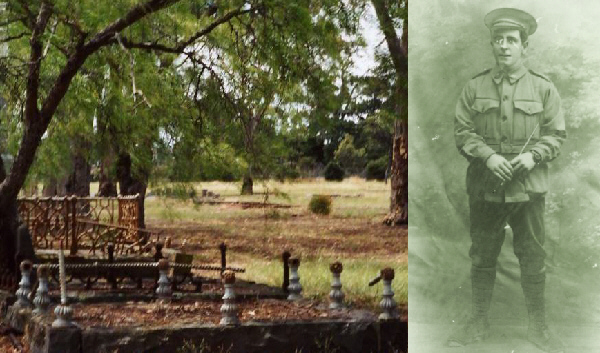
Private Robert John Bruce, AIF, and His Final Resting Place
Somewhere amongst the vandalized graves, rusting wrought iron railing and a few empty beer bottles, lays the final resting place of Private Robert John Bruce of C Company 46th Battalion, Australian Imperial Forces. His grave in the Will Rook Cemetery located in Melbourne's outer suburb of Broadmeadows is almost impossible to find as many graves have long since disappeared through years of wanton destruction and an indifferent public appreciation of the historical significance of the cemetery.
Private Bruce was wounded at Pozieres on 4 August 1916 during the Battle of the Somme and after 8 weeks in hospital returned to fight at Bullecourt and Ypres, and after another wounding was invalided home on 18 September 1917. Unfortunately, he died of war related injuries on 21 November 1918, aged 33. His parents, John and Mary Bruce, laid their son to rest with due reverence and the knowledge that he had made the supreme sacrifice for King and country. As the next of kin, a grateful British Government sent his parents a Memorial Death Plaque commonly called the "Dead Man's Penny" by the troops.
The history of the Dead Man's Penny began in 1916 with the realization by the British Government that some form of an official token of gratitude should be given to the fallen service men and women's bereaved next of kin. The enormous casualty figures not anticipated at the start of WWI back in 1914 prompted this gesture of recognition. In 1917, the government announced a competition to design a suitable plaque with a prize of 250 pounds. There were 800 entries from all over the Empire, the Dominions, and even from the troops on the Western Front. Mr E Carter Preston of Liverpool, England, the eventual winner.
The selected design was a 12-centimetre disk cast in bronze gunmetal, which incorporated the following; an image of Britannia and a lion, two dolphins representing Britain's sea power and the emblem of Imperial Germany's eagle being torn to pieces by another lion. Britannia is holding an oak spray with leaves and acorns. Beneath this was a rectangular tablet where the deceased individual's name was cast into the plaque. No rank was given as it was intended to show equality in their sacrifice. On the outer edge of the disk, the words, 'He died for freedom and honour'.
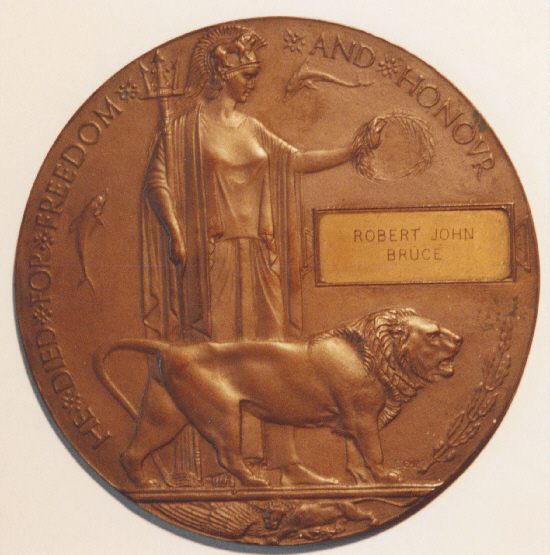
Private Bruce's Memorial Plaque and His Final Resting Place
A scroll, 27 x 17 centimeters, made of slightly darkened parchment headed by the Royal Coat of Arms accompanied the plaque with a carefully chosen passage written in old English script,
He whom this scroll commemorates was numbered among those who, at the call of King and Country, left all that was dear to them, endured hardness, faced anger, and generally passed out of sight of men by the path of duty and sacrifice, giving up their own lives that others may live in freedom. Let those who come after see to it that his name be not forgotten.
Beneath this passage, written in the same style, was the name, and rank and service details of the deceased. To accompany the scroll, again in old English script, a personal message from King George V.'
I join with my grateful people in sending you this memorial of a brave life given for others in the Great War. George R I.
The plaques were packaged in stiff cardboard wrapping folded like an envelope and sent to the next of kin. Production of the plaques and scrolls, which was supposed to be financed by German reparation money, began in 1919 with approximately 1,150,000 issued. They commemorated those who fell between 4 August 1914 and 10 January 1920 for home, Western Europe and the Dominions whilst the final date for the other theatres of war or for those died of attributable causes was 30 April 1920.
Unfortunately, the production and delivery of the plaques was not a complete success and the scheme ended before all the families or next of kin of the deceased received the official recognition they should have. There were some relatives who returned the pennies to the Australian Government in protest as they felt it was insulting and it did not replace their loved one's life. Of course, nothing can replace a life lost but for those 'Dead Man's Pennies' that are in private or public collections, museums and national archives, they are a constant reminder of the ultimate price paid by the men and women of the armed services during the Great war of 1914-1918. © Ken Wright, 2004
|
|

First Action for the AEF: The Battle of Cambrai
|
The AEF made one notable and surprisingly early appearances on the Western Front in November 1917. The 11th Engineering Regiment which specialized in railroad construction was caught on the Cambrai battlefield when the Germans mounted a surprise counteroffensive. Contributor Craig Pickard shares these details:
This article was printed in the 1930's UK magazine called I Was There. The author of the article is Major General Seely of the Canadian Cavalry Brigade. He describes the German counter attack at Cambrai between November 30th to December 4th, when the Canadian Cavalry fought a rear guard action to stop the German advance.
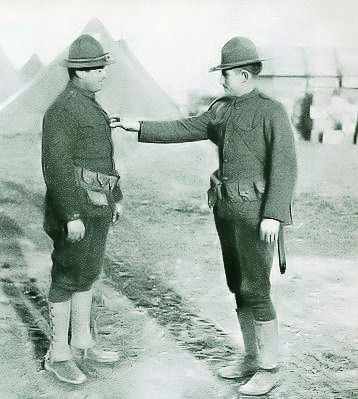
This Article appeared with the image above (credited to the Imperial War Museum London) with the following caption:. "The Engineers of the American Army. Here are 2 men of the 11thEngineers, Sgt. McIsaac and Sgt. Cairola who went through the German barrage to rescue Sgt Haley who had been wounded at Gouzeaucourt on the 20th November 1917".
I have to say that a good many stragglers from the battle gallantly came forward with me. Amongst others we found a curious and most interesting party, American engineers whom we had seen 12 days before, engaged in making a light railway some five miles behind the front line. They were pursuing their peaceful avocations near to Gouzeaucourt, which had been close to the front line before our advance on November 21. They belonged to the 11th Engineers (Railways).
I remember Colonel Hoffman was the Regimental Commander and I think Captain Hulsant was commanding the Gouzeaucourt party. When the German advance fell on upon them. Some had rifles with them, in the case of others they were far away, but that made no difference to these gallant Yankees. With spades and pickaxes they fell upon the advancing Germans and although many were knocked out, I was assured that they got the best of it in a hand to hand combat.
It was a brave thing to do, for surrender would have been easy and for once justifiable. When I came home on leave a month later, I gave some account of this at a luncheon, given by Sir Max Aitken (Later Lord Beaverbrook). I do not know if this account has reached America from other sources, but I am glad to put it on record now.
Source: The Doughboy Center
|
|
|
Thanks to each and every one of you who has contributed material for this issue. Until our next issue, your editor, Mike Hanlon. |
|
 (Or send it to a friend)
(Or send it to a friend)
|
Design by Shannon Niel
Content © Michael E. Hanlon
|
|
|











